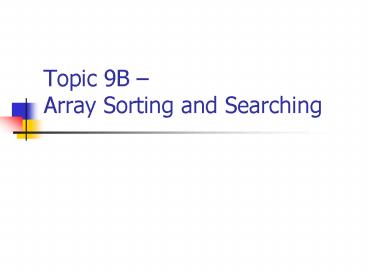Topic 9B Array Sorting and Searching - PowerPoint PPT Presentation
1 / 16
Title:
Topic 9B Array Sorting and Searching
Description:
At each element, we look to the right and find the lowest value. Once we find the lowest value (to the right of the current element), we swap the ... – PowerPoint PPT presentation
Number of Views:49
Avg rating:3.0/5.0
Title: Topic 9B Array Sorting and Searching
1
Topic 9B Array Sorting and Searching
2
Algorithms
- An algorithm is a set of steps that can be
followed to solve a problem. - Designed and developing an algorithm is often the
most difficult part of the problem-solving
process. - For each problem, there can be many different
algorithms that correctly solve the problem.
3
Algorithms
- Some algorithms may do so faster than others that
do the same thing (algorithms that solve the same
problem may vary in efficiency). - Some algorithms may be easier to understand and
may make more sense than others that do the
same thing (algorithms that solve the same
problem may vary in complexity).
4
Introduction to Sorting
- Many of the algorithms that operate on data
contained within an array require the data in
that array to be sorted. - This means that the data contained in the array
needs to be in order, from lowest-to-highest, or
vice versa. - We will examine a simple technique for putting
the array in lowest-to-highest order. - Note that once this problem is solved, the
reverse, putting the array in highest-to-lowest
order, is trivial.
5
Introduction to Sorting
- There are many approaches to sorting.
- Some sorting algorithms are much better than
others. - We will examine one of the simplest sorting
algorithms, a selection sort. - This algorithm is intuitive (easy-to-understand),
although it is not very efficient.
6
Selection SortThe Basic Idea
- The basic idea of the selection sort is to
process the array from left-to-right (index 0,
index 1, etc) - At each element, we look to the right and find
the lowest value. Once we find the lowest value
(to the right of the current element), we swap
the two elements. - Then, we move onto the next element and repeat
the process.
7
Selection SortThe Algorithm
- (1) current_element 0
- (2) Find index_of_min, the index of the smallest
element in the subarray, arraycurrent_element
to arraysize 1 - (3) If current_element does not equal
index_of_min, swap elements at current_element
and index_of_min - (4) If current_element size 1 , stop. Else
current_element goto step (2)
8
Selection Sort An Example
24
98
4
3
55
62
3
24
4
98
24
98
98
55
98
62
X1
X2
X3
X4
X5
X0
9
Sorting Algorithms
- Keep in mind that a selection sort is simply one
method of sorting an array. - It is a very simple-to-understand approach.
- It is also not very efficient.
- Other sorting algorithms that are much more
efficient, although much harder-to-understand,
include the bubble sort and the quicksort. We
will not discuss these algorithms.
10
Introduction to Searching
- Searching an array is a closely related problem
to sorting an array. - The simplest approach to array searching is the
linear search. - This searching method consists of examining the
array elements from left to right. - If the target is found, we save the index it was
found at and stop. If not, and there are still
more array elements to the right, we move to the
next element and repeat.
11
The Linear Search
- Thus, we simply start at index 0 and see if the
target is there. If so, we stop. - If not, we move to index 1 and see if the target
is there. - If not, we move to index 2 and see if the target
is there. - etc
12
Linear Search An Example
We will perform a linear search on the array X in
order to find the target value of 55.
24
98
4
3
55
62
X1
X2
X3
X4
X5
X0
55 is located at index 4!
13
Searching Algorithms
- The linear search is not a very efficient
algorithm. - Notice that this algorithm does not depend on, or
require, that the array is sorted, or in any
order at all. - If the array is sorted, we can use a much more
efficient searching algorithm, the binary search.
14
The Binary Search
- The binary search is very intuitive.
- (1) Begin with the entire array
- (2) Select the middle element.
- (3) If the target is less than the middle
element, choose the next subarray to be the half
of the array to the left (smaller than) the
middle element. If the target is greater than
the middle element, choose the next subarray to
be the half of the array to the right (greater
than) the middle element. - (4) Then, repeat on the new subarray.
15
Binary Search An Example
We will perform a binary search on the array X in
order to find the target value of 55.
3
4
24
25
55
62
98
X1
X2
X3
X4
X5
X0
X6
55 is located at index 4!
16
Summary
- Searching and sorting arrays are common problems
in computer science. - Both problems, like almost all problems, have
multiple solutions. - Solutions vary on complexity and efficiency.
- We have examined the selection sort, the linear
search, and the binary search.































